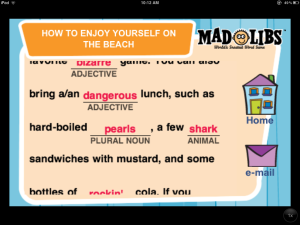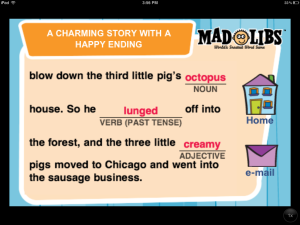My students love anything that incorporates hilarity and the iPad. I love anything FREE that does that! A lot of my speech sound students are serviced through RtI (maybe I’ll blog about how we are piloting that here later) and I see them for short 10-15 minute bursts where we do a lot of repetitions in a short time. Sometimes, they get horribly bored. So, with the iPad and the free MadLibs app (for iPhone/iPod) we use their sounds to fill out the story and read it. Here’s an example of a completed MadLib done for /r/:
When you go to the beach, you must take along a big blanket, a thermos bottle full of relish, lots of suntan rotten radishes, and a couple of folding chairs. Then you put on your shirt so you can get a beautiful purple to last you all summer. You also should have a big hat to keep the sun off your armpit. If you want exercise, you can find some worms to play volleyball with. Volleyball is America’s favorite bizarre game. You can also bring a/an dangerous lunch, such as hard-boiled pearls, a few shark sandwiches with mustard, and some bottles of rockin’ cola. If you remember all of the above and get a place near a/an red hot lifeguard, you can sunbathe royally all day.
I also have a lot of students working on parts of speech so the MadLibs are great for that as well. We sometimes start by listing the possibles on our board before beginning. They often need to use the “hints” option in the game until they get comfortable with the different parts. I have actually seen a large improvement in my older students after using this activity a few times. Here’s a screenshot of the game used this way:
There are 5 free MadLibs offered in the free version. There are more that you may purchase additionally.
How do you use MadLibs in therapy? Please share your suggestions!


I use MadLibs all the time in therapy. For my articulation groups, I give a word list with their sounds in various word positions & listed under the different parts of speech. The students love reading their sounds aloud while they are practicing. For my language students, I use them as a review for the parts of speech taught in therapy.